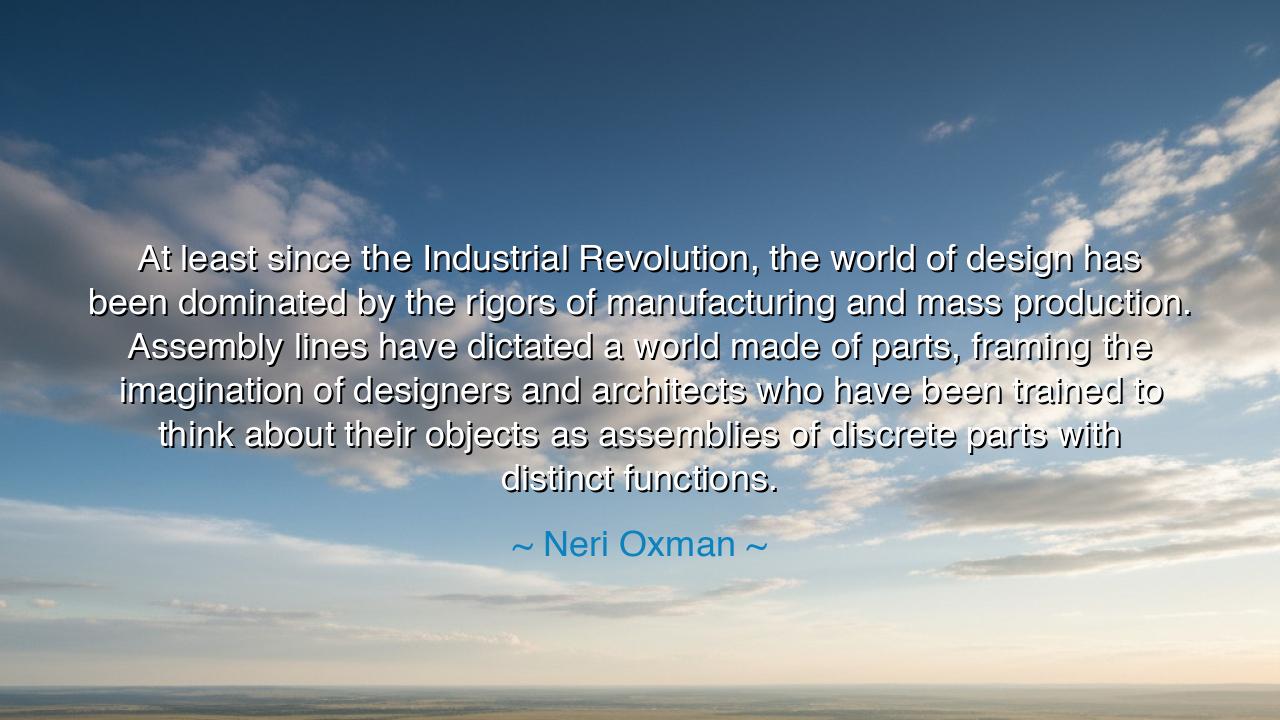
At least since the Industrial Revolution, the world of design has
At least since the Industrial Revolution, the world of design has been dominated by the rigors of manufacturing and mass production. Assembly lines have dictated a world made of parts, framing the imagination of designers and architects who have been trained to think about their objects as assemblies of discrete parts with distinct functions.






When Neri Oxman, the visionary architect and designer, wrote, “At least since the Industrial Revolution, the world of design has been dominated by the rigors of manufacturing and mass production. Assembly lines have dictated a world made of parts, framing the imagination of designers and architects who have been trained to think about their objects as assemblies of discrete parts with distinct functions,” she was not merely describing the machinery of industry — she was revealing the architecture of modern thought. Her words rise like a lament and a call to awakening. For she saw that since the dawn of the Industrial Revolution, human creativity had become bound by the logic of the factory — by the rhythm of the machine rather than the pulse of life.
Oxman’s reflection springs from her study of both nature and design. She stands at the frontier where biology meets technology, where materials are not assembled but grown. Her quote speaks to the inheritance of the mechanical age — a time when efficiency became the new deity, and the assembly line its temple. In that age, the craftsman’s hand gave way to automation, and the designer’s imagination was confined to the geometry of repetition. Chairs, houses, cities — all began to reflect the logic of discrete parts, each performing a single function, all working together under the tyranny of uniformity. Humanity learned to build like machines — and in doing so, forgot how to build like life.
For before the machine came the maker, and before industry came the artisan. The ancients built as nature builds — continuously, holistically, organically. The marble of the Parthenon, the wood of a Japanese temple, the woven silk of a kimono — each was crafted as a living whole, every part shaped by the same breath of purpose. There was no division between art and science, between material and meaning. But with the rise of the assembly line, design itself fractured. A single object was no longer born from one mind or one vision, but from a chain of separated labors — each worker repeating, none imagining. Thus, as Oxman says, the imagination of designers was “framed” — not by creativity, but by the structure of production.
This transformation can be seen in the story of Henry Ford, whose assembly line revolutionized the twentieth century. In his factories, cars flowed like rivers of metal, each part fitted to another in precise sequence. It was a triumph of efficiency, yet also a narrowing of vision. Design became the servant of mass production, and the artist — once a philosopher of form — became a technician of function. The world grew faster, but not deeper. We learned to produce abundance, yet much of it lacked soul. In this lies the heart of Oxman’s lament: that in our devotion to the mechanical, we have forgotten the organic unity from which true beauty arises.
But Oxman is not content to mourn; she seeks to restore. Through her work in material ecology, she teaches that design must return to the wisdom of nature — to systems that grow, adapt, and heal rather than merely assemble. A leaf is not made of parts, but of patterns; a bone does not have separate functions, but seamless gradations of strength and flexibility. Nature designs through continuity, not fragmentation. To Oxman, the challenge of the future is to break free from the legacy of the assembly line — to imagine again as nature imagines, where structure, function, and form are one.
Her vision recalls the great truth of the ancients: that creation is not addition, but integration. Just as the body is not a collection of organs, but a harmony of systems, so too must our creations become living unities rather than dead constructions. She invites us to see the future of design not in bolts and beams, but in the weaving of new materials that grow like coral or bone — where every cell contributes to both strength and beauty. This is not mere innovation; it is a philosophy of being, a return to the sacred balance between the maker and the made.
And so, O learner of life, take this teaching to heart: the world we build reflects the way we think. If our minds are divided, our creations will be fractured; if our minds are whole, our creations will breathe. Let us not design merely with the hand or the algorithm, but with the same wisdom that shapes a tree or a seashell. Learn from Oxman’s words that efficiency without unity is hollow, and that progress without soul is ruin. Strive to create as the ancients did and as nature still does — with harmony, with continuity, with life itself as your teacher. For the truest design is not assembled; it is born.






AAdministratorAdministrator
Welcome, honored guests. Please leave a comment, we will respond soon